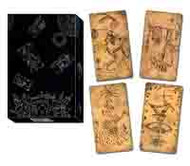Overlooked Treasure: The Lost Code of Tarot
Posted by Dan Pelletier on May 6th 2018
The Lost Code of Tarot – A Review
The main problem with this deck is that it may end up gracing shelves of collectors, and never get used in the real world.
It is not however, in my opinion, a deck for beginners. This is a deck for intermediate to advanced readers. It’s a reading deck folks. So let’s look at it from a few different angles as I pontificate.
This deck is not based on either Hermetic or Hebrew Kaballah, Crowley’s Thoth, Rider’s Waite Smith, Etteilla’s Book of Thoth, not a Tarot de Marseille or Piedmontese… It’s constructed on and of its own architecture.
Hold up a sec. Let’s look at what the marketing hype says…
Amazon sez: “The project revolves around the works of fictional Alchemist, a mysterious manuscript and a deck or [sic] Tarot cards, both coded with a complex cipher. Inspired from Leonardo da Vinci's codes, the Voynich Manuscript along with the oldest surviving decks or tarot cards, the deck is full of symbols, allegorical images and esoteric languages, echoing a sense of magic and mystery typical of time where ancient myths and new ideas were fused. Andrea Aste. This set contains 80 cards and 160 page colour book. Cards measure 66 x 120 mm. Magnetic hard-box containing cards and book measures 205 x 135 x 50mm.”
It doesn’t say that the art is reminiscent of Picasso, or Enzo Viviani, playful and joyous. In fact it says little.
Llewellyn: “Enter a parallel world where tarot comes to life. Designed by artist Andrea Aste to look like it was created during the era of the master alchemists, the Lost Code of Tarot is full of allegorical images and esoteric languages. Inspired by the codes of Leonardo da Vinci, this deck is reminiscent of a time when science and magic were fused together and a place where wisdom emerges from the space between the lines.”
Yeah yeah yeah but none of that captures what the deck really is. It’s really much deeper. It’s “bigger on the inside”. Marketing folks don’t get more than a glance inside. They don’t convey how it looks. How it reads. How it handles in the curves.
Let’s say you want to read with RWS meanings. And you want to read pip cards, and don’t really want to learn a new system…so overlay meanings with this deck. Read Crowley but don’t feel like Harris today? So pick up this deck and overlay meanings. Marseilles? Overlay.
This deck is whimsical. It’s fun. You are invited to enter the fantastical backstory, but it is not really necessary. The images contain all the accepted bits from the standard tarots.
Cosmetically the deck is printed with black, and bits of red ink, on a sepia base. The limited palette conveys the work well.
Beauty conveyed through complex simplicity.
It emotes.
That makes it even more fun. Then when you figure out the labels used on the cards, and learn the marking for the suit majors, it’s even more fun.
There’s one page in the book that tells you how to decode the ‘language’ of the deck. Other than that – you’re on your own. And that makes it even more fun.
Enrique Enriquez once said, "Every time we blink the tarot suffers another mutilation. It has become whatever an editor wants it to be. This process has evolved as one might expect, starting in the 18th century as a concoction whose main ingredient was the ego of several successive authors, by the 20th century becoming a set of inventions motivated by pure financial interest. The market basically needs something new to sell every month: “If we already sold the Kabala, and the mermaids, now we can sell the Mermaid’s Kabala”.
Well The Lost Code of Tarot sidesteps this entire issue. It is what you choose for it to be. It will morph into whatever mythos you wish – in a whimsical manner. It will give you what you give it. It will become, what you wish it to be.
Because this deck was produced with a fictional backstory – you the user are simply free to use the art. Or the backstory – or both. Or make your own.
The minors? They mean what you wish them to mean. And like the history of the deck, are as malleable as you wish them to be.
The extra two cards? I see them as "The Questioner" and "The Elephant Carrying the World on its Back"
This deck is a reader’s deck. Two thumbs up.
Available at The Tarot Garden

